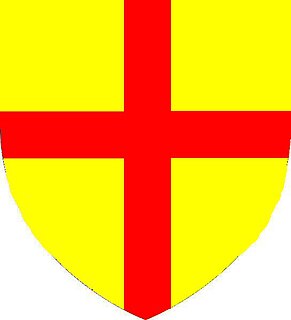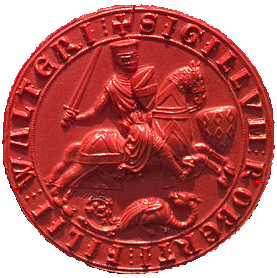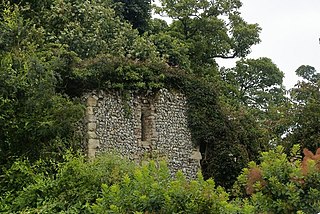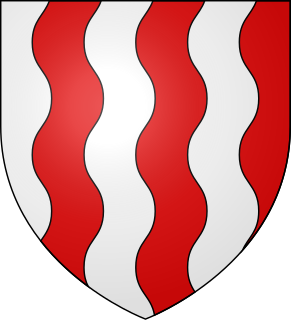Related Research Articles

Hugh Bigod was a member of the powerful early Norman Bigod family and was for a short time the 3rd Earl of Norfolk.

Robert Fitzwalter was one of the leaders of the baronial opposition against King John, and one of the twenty-five sureties of Magna Carta. He was feudal baron of Little Dunmow, Essex and constable of Baynard's Castle, in London, to which was annexed the hereditary office of castellan and chief knight banneret of the City of London. Part of the official aristocracy created by Henry I and Henry II, he served John in the wars in Normandy, in which he was taken prisoner by King Philip II of France and forced to pay a heavy ransom.
Elizabeth of Vermandois, was a French noblewoman, who by her two marriages was the mother of the 1st Earl of Worcester, the 2nd Earl of Leicester, the 3rd Earl of Surrey, and of Gundred de Warenne, mother of the 4th Earl of Warwick.

Waleran de Beaumont, 4th Earl of Warwick was the second son of Earl Roger of Warwick and Gundreda de Warenne, daughter of William de Warenne, 2nd Earl of Surrey and Elizabeth de Vermandois. He was known in his elder brother's time as 'Waleran of Warwick' marking the shift of surname in the family in his generation. The surnames 'Beaumont' and 'Newburgh' were used by the first two generations of the family, and are applied to the later generations by convention.

Aubrey de Vere, 2nd Earl of Oxford, hereditary Master Chamberlain of England, served in military campaigns under King Richard and King John. He was succeeded in the earldom by his brother, Robert de Vere, 3rd Earl of Oxford.
Robert I de Brus, 1st Lord of Annandale was an early-12th-century Anglo-Norman lord and the first of the Bruce dynasty to hold lands in Scotland. A monastic patron, he is remembered as the founder of Gisborough Priory in Yorkshire, England, in present-day Redcar and Cleveland, in 1119.

Benington Castle is a ruined castle in the village of Benington, near Stevenage in Hertfordshire, England at grid reference TL296236. It has been protected since 1936 as a scheduled monument.
Roger Fitzmiles, 2nd Earl of Hereford, was an English noble who played an active and influential part in the wars between Empress Matilda and King Stephen.
Peter de Valognes (1045-1110) was a Norman noble who became a great landowner in England following the Norman Conquest.
Margaret of Huntingdon was a Scottish princess and Duchess of Brittany. She was the sister of Scottish kings Malcolm IV and William I, wife of Conan IV, Duke of Brittany, and the mother of Constance, Duchess of Brittany. Her second husband was Humphrey de Bohun, hereditary Constable of England. Following her second marriage, Margaret styled herself as the Countess of Hereford.
Eustace fitz John, Constable of Chester, was a powerful magnate in northern England during the reigns of Henry I, Stephen and Henry II. From a relatively humble background in South East England, Eustace made his career serving Henry I, and was elevated by the king through marriage and office into one of the most important figures in the north of England. Eustace acquired a great deal of property in the region, controlled Bamburgh Castle, and served jointly with Walter Espec as justiciar of the North.

William earl of Warwick was an English nobleman. He was married to Matilda de Percy, daughter of William de Percy and his first wife Alice of Tonbridge.

William de Valognes also known as William de Valoynes, was the only son of Philip de Valognes and was granted a charter of the baronies of Panmure and Benvie by King William the Lion, previously granted to his father. On his father's death in 1215, William de Valongnes was made High Chamberlain to Alexander II. He died in 1219 and was interred at Melrose Abbey.
Robert de Vieuxpont, also called Vipont, Veteripont, or de Vetere Ponte, Baron of Westmorland, was an Anglo-Norman noble landowner and administrator.
Roger de Valognes was an Anglo-Norman nobleman who held lands around Benington in Hertfordshire, a tenure that made Roger the feudal baron of Benington. In 1136 he was a supporter of King Stephen of England's seizure of the English throne from Matilda, the daughter of the previous king, Henry I. Roger built Benington Castle and gave lands to Binham Priory in the early part of Stephen's reign, but was dead by 1142. His barony passed to his first two sons in succession and his third son became a royal official in Scotland.
William de Chesney was a medieval Anglo-Norman nobleman and sheriff. The son of a landholder in Norfolk, William inherited after the death of his two elder brothers. He was the founder of Sibton Abbey, as well as a benefactor of other monasteries in England. In 1157, Chesney acquired the honour of Blythburgh, and was sheriff of Norfolk and Suffolk during the 1150s and 1160s. On Chesney's death in 1174, he left three unmarried daughters as his heirs.
Reginald de Warenne was an Anglo-Norman nobleman and royal official. The third son of an earl, Reginald began his career as an administrator of his brother's estates, and continued to manage them for his brother's successor, William, the second son of King Stephen. Reginald was involved in the process that led to the peaceful ascension of Henry fitzEmpress to the throne of England in 1154 and served the new king as a royal justice afterwards. He played a minor role in the Becket controversy in 1170, as a member of the party that met Becket on his return to England from exile in 1170.
Hugh de Cressy was an Anglo-Norman administrator and nobleman. Little is known of his ancestry and he first served two brothers of King Henry II of England before becoming a royal official. He was rewarded with a marriage to an heiress for his service to the king. In England he often served as a royal justice and witnessed documents, which showed his closeness to the king. On the continent, he recruited mercenaries for the royal army and was named constable of the castle of Rouen in the royal lands in France. He died in 1189 after giving lands to various monasteries before his death.

de Valognes is a family name of two distinct powerful families with notable descendants in the centuries immediately following the Norman Conquest. Although a connection between them has been inferred by some authorities, this is not supported by positive evidence.

Gundreda de Warenne, Countess of Warwick was the wife of Earl Roger. She was the daughter and eldest child of William II, earl Warenne by the Capetian princess Isabel of Vermandois daughter of Count Hugh the Great of Vermandois and niece of King Philip I of France. On the death of her first husband Count Robert of Meulan and Leicester in 1118 Isabel promptly married Earl William II de Warenne and since Gundreda had an infant daughter by 1138 it is most likely she was the eldest child of the marriage. The Flemish name Gundreda was given her in recollection of her father's mother Gundreda de Warenne.
References
- Crawford, George. The Lives and Characters, of the Officers of the Crown, and of the State in Scotland: From the Beginning of the Reign of King David I. to the Union of the Two Kingdoms. Collected from Original Charters, Chartularies, Authentick Records, and the Most Approved Histories. Volume 1. Robert Fleming, 1726.